Introduction
My term paper is about the young girl Ophelia, who is, among Gertrude, the only female character in William Shakespeare’s Hamlet. When we take a closer look on Ophelia’s character, we can easily see that she undergoes a change of behaviour in the play. In the first scenes she appears as a normal young girl of her period, but the process of becoming insane goes its way, which can be seen when she is singing her dialogue songs and finally when she commits suicide. During this process there are questions that come up: What is the reason for Ophelia’s insanity? Why is she such an obedient girl? Is Hamlet’s love to her real or just fake? The last two questions may help with the answering of the leading question about Ophelia’s insanity. In the following I use some feminist approaches to analyse Ophelia’s madness.
Table of Contents
- Introduction
- Discussing Task
- Conclusion
Objectives and Key Themes
The objective of this paper is to analyze the reasons behind Ophelia's descent into madness in Shakespeare's Hamlet, utilizing feminist approaches. The paper explores the societal pressures and constraints placed upon women in Elizabethan society, examining how these factors contribute to Ophelia's tragic fate.
- Ophelia's role as a passive and obedient woman in Elizabethan society.
- The impact of patriarchal control exerted by Polonius and Laertes on Ophelia's life choices.
- The nature of Ophelia's relationship with Hamlet and its influence on her mental state.
- The role of societal expectations and gender roles in shaping Ophelia's actions and ultimate demise.
- Ophelia's agency, or lack thereof, in the face of overwhelming circumstances.
Chapter Summaries
Introduction: This introductory chapter sets the stage for the analysis of Ophelia's descent into madness. It establishes Ophelia as a central female character in Hamlet, highlighting the transformation she undergoes throughout the play. The chapter poses key questions concerning the reasons for her insanity, her obedience, and the authenticity of Hamlet's love, framing the subsequent analysis within a feminist perspective. The author's intention to employ feminist approaches to understand Ophelia's madness is clearly stated.
Discussing Task: This chapter delves into the specifics of Ophelia's character and her interactions with significant male figures in her life – her brother Laertes, her father Polonius, and Hamlet. Ophelia is portrayed as a product of her time, embodying the passive feminine ideal of the Elizabethan era. Her obedience to patriarchal authority is emphasized through her interactions with Laertes and Polonius, demonstrated by her immediate reporting of Hamlet's visit to her bedroom. The chapter highlights the lack of agency in her life, shaped by the controlling influence of her father and brother, preventing her personal growth and independent thought. The ambiguous nature of Hamlet's love for Ophelia is also explored, suggesting that his affections might not be genuine. This lack of reciprocation from Hamlet, coupled with the societal constraints imposed on her, is positioned as a significant contributor to her mental deterioration.
Keywords
Ophelia, Hamlet, Shakespeare, Elizabethan Era, Feminism, Madness, Gender Roles, Patriarchy, Obedience, Agency, Love, Suicide.
Frequently Asked Questions: Analysis of Ophelia's Descent into Madness
What is the overall objective of this paper?
The paper analyzes the reasons behind Ophelia's descent into madness in Shakespeare's Hamlet using feminist approaches. It explores how societal pressures and constraints on women in Elizabethan society contributed to her tragic fate.
What are the key themes explored in this analysis?
Key themes include Ophelia's role as a passive woman in Elizabethan society; the impact of patriarchal control by Polonius and Laertes; the nature of Ophelia's relationship with Hamlet and its influence on her mental state; the role of societal expectations and gender roles in shaping Ophelia's actions and demise; and Ophelia's agency (or lack thereof) in overwhelming circumstances.
What are the main chapters covered in this analysis?
The analysis includes an introduction setting the stage for the analysis, a main chapter discussing Ophelia's character and interactions with key male figures, highlighting her constrained role and the ambiguous nature of Hamlet's love. A conclusion is implied, but not explicitly detailed in the provided summary.
What is the introduction's focus?
The introduction establishes Ophelia as a central female character in Hamlet, highlighting her transformation. It poses key questions about her insanity, obedience, and the authenticity of Hamlet's love, framing the analysis within a feminist perspective.
What does the main chapter ("Discussing Task") analyze?
This chapter analyzes Ophelia's interactions with Laertes, Polonius, and Hamlet, portraying her as a product of Elizabethan society's passive feminine ideal. It emphasizes her obedience to patriarchal authority, her lack of agency due to her father and brother's control, and the ambiguous nature of Hamlet's love as contributors to her mental deterioration.
What keywords are associated with this analysis?
Keywords include Ophelia, Hamlet, Shakespeare, Elizabethan Era, Feminism, Madness, Gender Roles, Patriarchy, Obedience, Agency, Love, and Suicide.
What kind of approach does this analysis take?
The analysis employs a feminist perspective to understand Ophelia's descent into madness, focusing on the societal and patriarchal constraints placed upon women in Elizabethan England.
What is the overall conclusion (inferred from the provided text)?
While not explicitly stated, the implied conclusion suggests that Ophelia's madness is a direct consequence of the restrictive societal expectations and patriarchal structures that defined her life in Elizabethan England, coupled with the ambiguity and potential lack of genuine affection from Hamlet.
- Quote paper
- Nathalie Drewes (Author), 2003, "William Shakespeare's 'Hamlet': What is the Reason for Ophelia's Insanity?", Munich, GRIN Verlag, https://www.grin.com/document/42556



